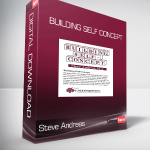Steve Andreas – Building Self Concept
Original price was: $39.00.$15.00Current price is: $15.00.
Beyond Self-Esteem, the power of the self-concept in motivating and directing a person’s behavior has been Format File: [1 VHS – Rip] File size: 325.53 MB
- Description
- Reviews (0)
Description
Steve Andreas – Building Self Concept
Building Self-Concept
Beyond Self-Esteem, the power of the self-concept in motivating and directing a person’s behavior has been recognized for years. This pattern, developed by Steve and Connirae Andreas, uses submodalities to elicit the existing structure of self-concept, and then build a new one with the same structure. In this demonstration Peter learned how to think of himself as lovable, and the wide-ranging impact of this change is demonstrated in follow-up interviews with Peter and his wife. (39 minutes in length.)
In this video, Steve shows us how to use submodalities (sensory distinctions such as bright/dim; loud/quiet; hard/soft) to strengthen self-concept. Steve’s client Peter learns to think of himself as loveable; and through follow-up interviews, you’ll hear how this change has affected Peter and his wife. To get maximum benefit from this tape, you’ll need prior NLP experience.
Get Steve Andreas – Building Self Concept download
Sample Seminar Notes –
The Belief Change processes are appropriate whenever there is a limiting belief, which is
typically a negation. The old limiting belief has to be weakened before the new belief is
installed, in order to avoid creating a conflict.
However, sometimes there is no limiting belief; the person just hasn’t built a useful
generalization for themselves that is durable. In this case you can find out how they
maintain a durable generalization and use that format to build a new one.
Some people are able to maintain a solid sense of themselves as having some attribute—
being capable, lovable, etc.—even when events or others around them temporarily
contradict these attributes. Other people are much more dependent upon others to continually
reassure them about an attribute even though they demonstrate it frequently in their
behavior, and they may take any denial of that attribute by a person or event very seriously,
no matter how many positive examples they have experienced.
1. Desired Attribute. Think of an attribute that is important to you as a person, but
which you only know is true of you by current external verification from others.
Some examples of attributes: being intelligent, worthwhile, appreciated, respected,
etc. What is an attribute that you would like to know is true of you? For instance,
when people tell you, “That was very kind,” do you go, “Huh?” in surprise, or
discount it in some way? Test by asking the person “Are you a (kind) person?” and
observe the nonverbal response.
Ecology: Select something which currently requires external conditions that get
you into trouble. For example, annoying others as a consequence of continually
asking them for reassurance. Please note this is different than checking externally in
an appropriate and useful way for feedback.
2. Self-Concept. Think of a personality trait that you like and know is true of yourself.
For example, you know you are intelligent, persistent, creative, considerate,
etc. You have a way of knowing this internally, even when a specific event obviously
contradicts this, or someone else disagrees with you at the moment. Test by
asking “Are you an (intelligent) person?” and observe the nonverbal response.
3. Notice how you represent the trait that you like and know is true, in terms of
submodalities. How do you represent that internal attribute so that your knowledge
that it applies to you is durable and long-lasting? Typically there is a “summary
representation,” an image, voice, or feeling that is used as a quick reference. Supporting
this is a more extensive “database” of examples, usually in the same representational
system. Ideally this database includes all representational systems.
Although it may seem paradoxical, a generalization is strengthened by including
several counter-examples (approximately 10%): times when you were not intelligent,
kind. loving, etc. If the person does not include counter-examples, take time
to access and include a few. This will result in the person feeling even more solid
about this characteristic.
4. Map Across. Take the attribute that you want to know internally is true of you,
and represent it in exactly the same way that you do the self-concept trait you like
and know is true of yourself. It may take a little time to access enough representations
of examples of this. Take the time to build this understanding thoroughly.
After accessing the database, create the “summary representation.”
5. Future-pace and Test. Take this new representation into a context in the future
where it will make a difference, and experience what it is like to know that this
attribute is true of you in that context. Also ask “Are you a (loving) person?”
and observe the nonverbal response. You should observe a nonverbal response
that is similar to what you observed in step 2 above (and different than what you
observed in step 1).
Click Add To Cart To Get Yours Now!
709D – DVD-R, 39 Minutes
About Steve Andreas, M.A.
Steve Andreas is co-founder with his wife, Connirae, of NLP Comprehensive. He is the author of Virginia Satir—The Patterns of Her Magic and co-author or editor of nine other NLP books and manuals of wide acclaim including the best-selling NLP book Heart of the Mind. Steve and Connirae’s contributions to the field include emotional transformation patterns for grief, shame, guilt and forgiveness, as well as pioneering in the areas of Timelines and submodalities.
Get Steve Andreas – Building Self Concept download
Below is Proof content:





Reviews
There are no reviews yet.